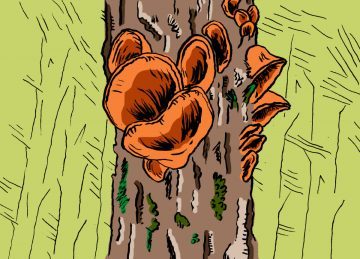Anna Journey at The Believer:
 “[F]ungi are the grand recyclers of our planet,” writes mycologist Paul Stamets in Mycelium Running, “the mycomagicians disassembling large organic molecules into simpler forms, which in turn nourish other members of the ecological community.” Certain fungi, known as saprophytes (from the Greek sapro: “rotten” and phytes: “plants”), feed upon decaying or dead organic matter. These industrious mushrooms—portobello, cremini, oyster, reishi, enoki, royal trumpets, shiitake, white button—speed up decomposition, restore and aerate soil, and provide food for other life forms, from bacteria to bears. “The yeasts and molds used in making beer, wine, cheese, and bread are all saprophytes,” notes journalist and food writer Eugenia Bone in Mycophilia. So rot-eating fungi helped civilize us, Bone notes, “if you consider good wine an indicator of civilization.”
“[F]ungi are the grand recyclers of our planet,” writes mycologist Paul Stamets in Mycelium Running, “the mycomagicians disassembling large organic molecules into simpler forms, which in turn nourish other members of the ecological community.” Certain fungi, known as saprophytes (from the Greek sapro: “rotten” and phytes: “plants”), feed upon decaying or dead organic matter. These industrious mushrooms—portobello, cremini, oyster, reishi, enoki, royal trumpets, shiitake, white button—speed up decomposition, restore and aerate soil, and provide food for other life forms, from bacteria to bears. “The yeasts and molds used in making beer, wine, cheese, and bread are all saprophytes,” notes journalist and food writer Eugenia Bone in Mycophilia. So rot-eating fungi helped civilize us, Bone notes, “if you consider good wine an indicator of civilization.”
“Fungi,” Stamets adds, “are the interface organisms between life and death.” During the cycle of rot and renewal, saprophytes degrade toxins, including a number of industrial chemicals and heavy metals we absorb through our skin and carry in our bloodstreams throughout our lives.
more here.
